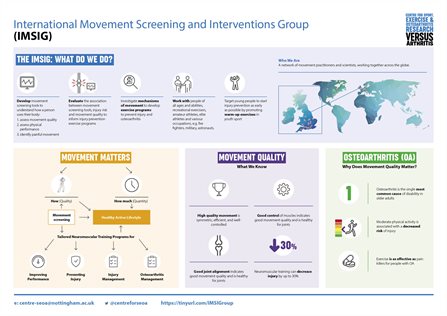Working Definitions of Movement Screening
Agreed by the International Movement Screening and Interventions Group (IMSIG) - updated 8th December 2016:
Overall definition:
Movement screening involves the quantitative or qualitative observation of a single movement and/or a composite battery of movements to predict injury or direct management of physical conditioning, injury prevention, rehabilitation, etc.

Types of movement screening:
Quantitative Movement Tests
The measurement of a quantitative outcome(s) of strength, power, balance or agility; often through multi-joint movements. An example is the distance covered during the Triple Single Leg Hop or Star Excursion Balance Test. The variables produced by these tests are continuous variables, e.g. the distance (cm) covered during a Triple Single Leg Hop or Star Excursion Balance Test. These tests are sometimes referred to Physical Performance Tests but performance testing is often used to describe more challenging tasks than some of the quantitative movement tests, so it is not an alternative term for this category of tests.
Movement Quality Tests
The identification and rating of compensations, asymmetries, impairments or efficiency of movement through transitional (e.g. squat, sit-stand, lunge) or dynamic (hopping, walking, landing, cutting) movement tasks. The variables produced by these tests are typically categorical variables. For example, some variables are dichotomous, such as yes/no, pass/fail, while others have more than two options, so are ordinal (e.g. poor/ fair/ good).
Purposes of movement screening:
- Determine physical capability (quantitative) and movement quality
- Identify painful movement
- Identify risk factors
- Guide management (e.g., inform referral, improve movement quality/efficiency, inform a training plan to increase physical capacity, conditioning, injury prevention, rehabilitation etc.)
- To direct referral for primary, secondary, tertiary prevention, defined in the context of injury and osteoarthritis:
- Primary prevention - protecting healthy people from developing or experiencing an injury via risk reduction strategies
- Secondary prevention - preventing re-injury or overuse to prevent progression to osteoarthritis / halting or slowing the progression of osteoarthritis in its early stages
- Tertiary prevention – learning to manage osteoarthritis and reduce its impact on function, joint longevity and quality of life.